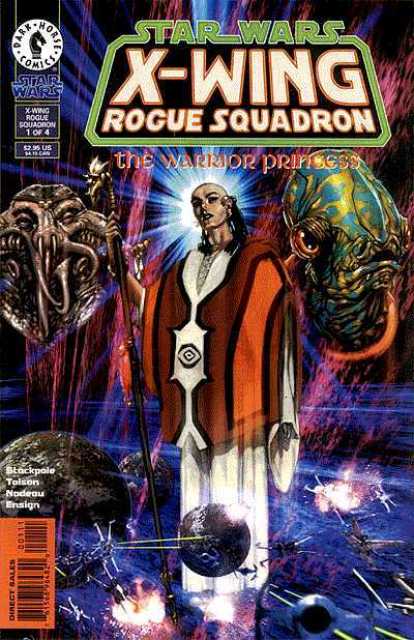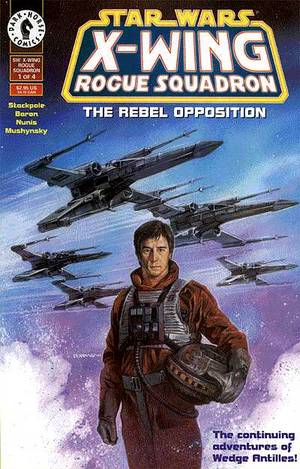Teenaged Ryan often felt it was in everyone’s best interests to let the people at Dark Horse Comics know how they were doing with the Star Wars property, and after having a letter published in the fourth issue of the original run of Shadows of the Empire—in which I complained that the dialogue from Rogue Squadron was unrealistic—I felt I had to make amends. The first issue of Rogue Squadron: The Warrior Princess published a letter from me in which I mentioned, in essence, that in terms of the portrayal of the rogues, these comics were way better.
Which is insane of course, because teenagers never know how good they have it, and I was no exception. Like the novels they were related to, the Rogue Squadron comics were an unprecedented, risky, and unique Star Wars which we all should run back and reread right now.
When I really started to get into the new Battlestar Galactica, I remember wondering if Ronald D. Moore and company had read the Rogue Squadron comics. I’m not saying BSG ripped off Rogue Squadron or anything (let’s not muck-up all those old Cylon graves!) but there’s something about just focusing on a group of space fighter pilots that is endlessly interesting. The TV show Space Above and Beyond attempted it, as did the once-popular (and Mark Hamill-y) Wing Commander computer games. But what’s so appealing about this concept, and how do the Rogue Squadron comic books avoid making all the stories seem like Top Gun in space?
Just like the X-Wing books with which they share a universe, the Rogue Squadron comics don’t really hold the readers hand all that much with what they’re getting into. If the novels had to fight against a perception of being simply marketing tie-ins for X-Wing video games, then the comics had a much bigger hurdle to overcome, a reaction that was probably like “what am I even looking at here?” The words ‘Star Wars’ aren’t even all that big on the title, and the characters who feature on the covers of these comics aren’t people you really even know. Which is why these comics were so great.
Set a few years before the events of the X-Wing books, the Rogue Squadron comics chronicle the adventures of a different incarnation of the elite flying folks, which we’re lead to believe is directly descended from the version of “Red Squadron” who flew during the Battle of Endor in Return of the Jedi. This puts the events of these Rogue Squadron stories at 4ABY, which means we’re dealing with things that happen just months after the Rebellion “won.” Whereas the X-Wing novels incorporated a lot of the statecraft necessary for the formation of the New Republic, the comics go for more of a “mission of the week” approach to the stories, making Rogue Squadron into a combination of the A-Team and Ghostbusters in space. If you’ve got an Imperial problem, and you can find them, maybe you can hire Rogue Squadron!
Instead of employing a reader surrogate like Corran Horn, Michael Stackpole actually gives these comics and even more ensemble feel than the books. Here equal “screentime” is given to Wedge, Tycho, Ploor Illo, Ibitsam, Dllr Nep and others. (Notably, Dllr Nep is from Sullust, like Lando’s copilot Nien Nunb, but Dllr Nep is not related to Nien. A later Rogue Squadron pilot, Aril Nunb, is related to Nien, and is also a girl. Teenage Ryan discovered this when he asked Dark Horse a question in a fan letter! Confusing!)
 What’s great about the characters of this version of Rogue Squadron is the reoccurring female characters like Ploor Illo aren’t relegated to being someone’s love interest or a secret spy in the same way things go down in the novels. Ploor, in fact is a secret member of royalty, a fact which becomes bonkers in “The Warrior Princess” storyline. Imagine a version of Starbuck from BSG crossed with Delenn from Babylon 5 and you’ve got Ploor, which on its own, already makes these comics worth reading.
What’s great about the characters of this version of Rogue Squadron is the reoccurring female characters like Ploor Illo aren’t relegated to being someone’s love interest or a secret spy in the same way things go down in the novels. Ploor, in fact is a secret member of royalty, a fact which becomes bonkers in “The Warrior Princess” storyline. Imagine a version of Starbuck from BSG crossed with Delenn from Babylon 5 and you’ve got Ploor, which on its own, already makes these comics worth reading.
The comics stories started with “The Rebel Opposition,” which, true to its name, is all about Rogue Squadron encountering people who actually don’t like the Rebels. Swiftly, other locales and subjects were explored, with “Battleground: Tatooine being a particular favorite of mine. Whether dealing with Imperial turncoats (“In the Empire’s Service”), crazy warlords (“Warrior Princess”), or straight-up espionage murder-mystery (“The Phantom Affair”), the Rogue Squadron comics were offering up tons of Star Wars excitement without relying on tearing the galaxy apart or busting out lightsabers every three seconds. This, then, was the closest thing to what a Star Wars TV live-action TV show should have been. The real men, women, and squids of the Rebellion getting assigned awesome missions all the time.
Like a lot of good Star Wars comics, and the novels too, it’s important to note that the Rogue Squadron comics—while action packed—aren’t super violent. Sure, these people are blowing up a lot spaceships and badguys, but like I mentioned before, there’s a certain A-Team style-action here that is (for the most part) bloodless. This isn’t something I think is bad by the way, but instead, is a great example of how Stackpole and company made these comics fun, but also in the spirit of a more carefree Star Wars.
If you simply can’t get enough the Rogues, but want something a little less immersive or character-driven then the novels, there’s few Star Wars comics you can get into that are more fun than these. But just like the novels, you always feel like all the folks in Rogue Squadron could be you, if you lived—and worked—in a galaxy, far, far away.
Ryan Britt is a longtime contributor to Tor.com.










